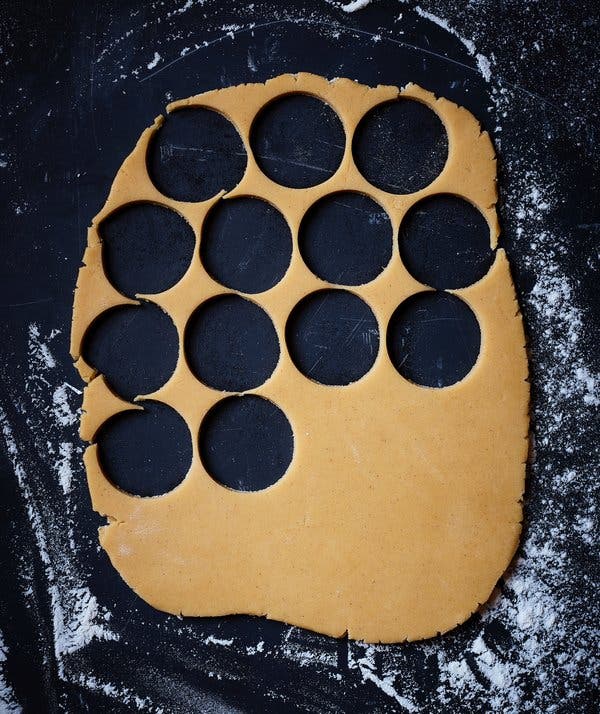For one brief and mostly glorious moment in 2013, my son, Joshua, and I had a cookie business. We had a kitchen that was as compact as a toy boat’s galley and a shop the size of a capsule hotel room. But the store’s design was beautiful — thank you, Joshua Greenspan — and just seeing the stacks of cookies made me smile. And the cookies were good! At least we thought so. Early on, we decided that we had to be the judges of what was good and what matched our style. If that sounds liberating, it wasn’t. It made us crazy and not much fun to be around either. We became just the kind of food snobs neither of us can stand.
Give us a chocolate-chip cookie, even one made with our favorite chocolate, and we’d tear it apart. Too crisp. Too chewy. Too sweet. We were impossible. And if we were hard on other people’s cookies, we were brutal on our own. I’d make something I thought was good, and Joshua might not agree. When he didn’t love the cookie, I cried. It’s a miracle we still like each other — or cookies.
These days I’m a pretty ecumenical cookie lover, although I find myself turning most often to sablés, which I use as building blocks, making cookie sandwiches with them and often flavoring them with herbs, spices, tea or toasted nuts. The more I make them, the more I appreciate their elegance and their cunning: They’re plain Janes with a sybarite’s soul.
The word sablé is French for sandy and is often pinned on shortbread. It’s not the most charming culinary word, but it aptly describes the lovely bit of graininess so characteristic of shortbread. With these cookies, everything depends on the ingredients, of which there are few, and the way you work with them, which should be gently. A classic sablé might have eggs or might not; it has sugar, but it shouldn’t have too much; and it always has butter — it might just as well be called a butter cookie. A shortbread that isn’t melt-in-your-mouth buttery ought to be banished from the clan.

CreditJohnny Miller for The New York Times. Food stylist: Maggie Ruggiero. Prop stylist: Colin King.
For years, my two favorite sablés were one I made for the shop, a slightly caky cookie (using just yolks made the texture more delicate), and the tad crisper, scallop-edged shortbread called Punitions, from the Poilâne boulangerie in Paris. The Poilâne cookies are a lesson in the importance of fine butter (the bakery uses tangy cultured butter) and careful mixing. I was lucky to get that lesson directly from Lionel Poilâne.
Poilâne had given me the recipe for the cookies, and to ensure that I’d get them right, he made them with me by hand. If I kept a scrapbook of great baking moments, this one would be among my most prized. Although it was almost 20 years ago, my hands hold the memory of how the dough felt at each moment; how lithe the sugar and eggs were before he rubbed in the butter; and how the dough formed chubby curds before he kneaded it into a ball with a few swift and graceful motions refined over 40 years of practice.
The recipe for Punitions and the history of the cookies, beloved since the boulangerie was founded in 1932, are in my friend Apollonia Poilâne’s new book, “Poilâne, The Secrets of the World-Famous Bread Bakery.” There are recipes for the artisan breads that are at the heart of the boulangerie and for the new breads, homey loaf cakes and cookies created by Apollonia, Lionel’s daughter, who now heads the business. It was among these that I found my latest inductee into the pantheon of great shortbread cookies, Punitions’ first cousins, corn sablés.
Grains, the baker’s ur ingredient, are Apollonia’s passion, and corn is her weakness. While corn is rarely seen in French pastries, Apollonia came to love it when she was at Harvard, where cornbread was served on Sundays and she’d pocket an extra hunk for breakfast on Mondays. She has made corn brioche — not at all like cornbread but close enough to bring back memories; a hearty corn loaf with flax seeds; and the corn sablés, which I’ve been baking weekly ever since I got the recipe.
The corn sablés are made with a mixture of all-purpose wheat flour and corn flour, which is a type of cornmeal so finely milled that you can barely feel the grain’s grit. Yet when it’s baked, it makes cookies that can rightly be called sablé. The dough is made quickly and needs just a short rest in the refrigerator before it’s rolled out. It rolls easily, cuts cleanly and best of all keeps its shape in the oven. Soft when just baked, the cookies cool to shortbread’s quintessential texture: crisp to the bite, tender to the chew. The dough is so well behaved that you could use it to make fanciful cutout cookies and decorate them for the holidays, but that’s not Apollonia’s idea of what they should be. “I like the cookies round, so they look like minisuns,” she told me, and indeed, the corn flour gives them that warm, golden color. She also likes them neat — the dough has no salt and no flavoring of any kind — so they taste of their good and natural ingredients. Even in my toughest tough-cookie days, I’d have had a soft spot for these.
Recipe: Poilâne’s Corn Sablés




